We’ve all been there. You have a container of milk in the refrigerator that has a “best by” date. The yogurt on the top shelf has a “sell by” date, and the rolls you just purchased have a “freshest by” date. But what does all of that mean, exactly? Does it mean that all of those foods will be inedible by the date given? Or just won’t taste quite as good? Should you throw them away a few days after the date? Or on the date? Or a day before, just to be safe?
As a mother of two small children, there is a lot of chaos in my house. When it comes to food, I want to know the latest possible date we can consume something. I don’t have time to guess or calculate based on vague cues from the milk or yogurt or bread companies. Apparently, I am not alone in my frustration.
A recent New York Times article touched on this very issue. It turns out that every company (currently) has the ability to determine the shelf life for its products, and what language to use to communicate that to its customers:
More than 10 different phrases are used to inform consumers about when to use or discard food, according to the Grocery Manufacturers Association and the Food Marketing Institute, the two large trade groups that represent major food producers and grocery chains. As a result, many people are confused about exactly when to throw out food.
On Wednesday, those two groups, and Walmart, announced that they had agreed to whittle that lexicon to just two phrases: “best if used by” and “use by.”
They said they hoped the change, which is voluntary, would be embraced by the vast majority of food manufacturers and producers sometime next year.
The fact that Walmart, the country’s “largest grocery retailer,” is involved could actually make the difference. It increases the chances that other grocers will follow suit. As for the language that the involved parties have chosen, “best if used by” and “use by” are intended to lend a little more clarity to shoppers. The former phrase will tell consumers after what date a product might not be as good (but will still be safe to consume), and the latter will indicate a date by which a product can safely be used.
Aside from mitigating confusion in the grocery store aisles, this effort is intended to help cut back on food waste, which is “…an issue of growing concern as consumers learn more about the effect that food production and consumption have on the environment.”
“Eliminating confusion for consumers by using common product date wording is a win-win because it means more products will be used instead of thrown away in error,” Jack Jeffers, vice president for quality assurance at Dean Foods, said in the statement released by the grocery manufacturers group. “It’s much better that these products stay in the kitchen — and out of landfills.”









Join the conversation as a VIP Member